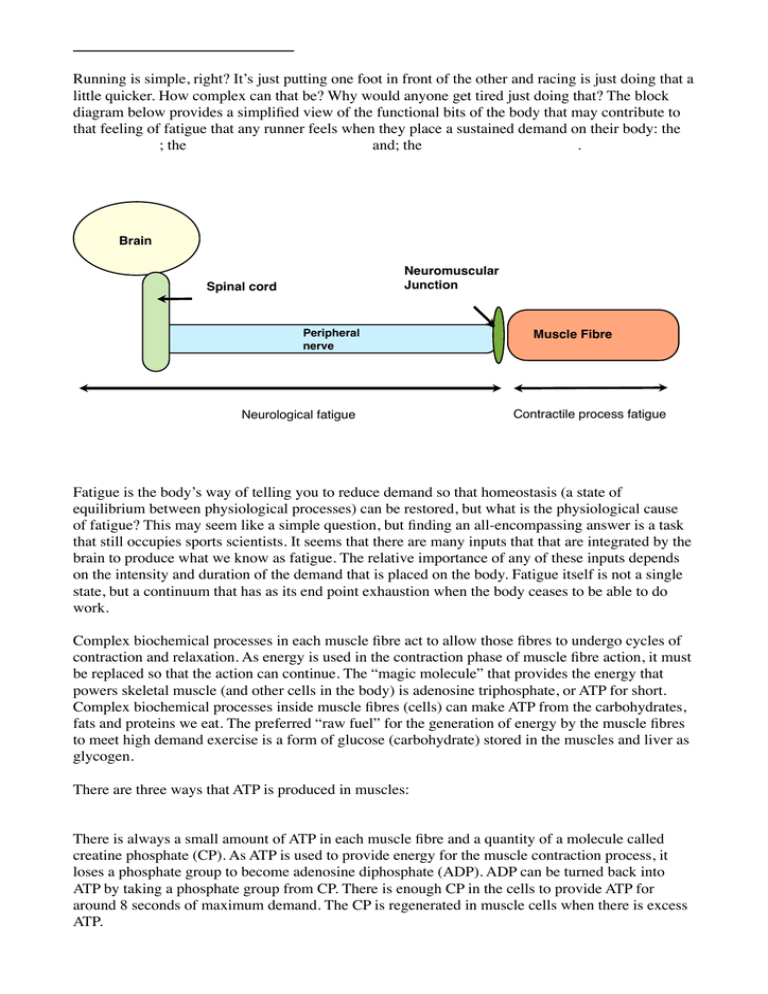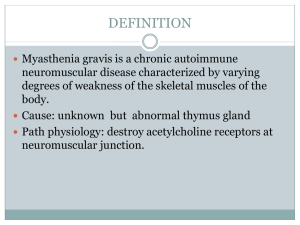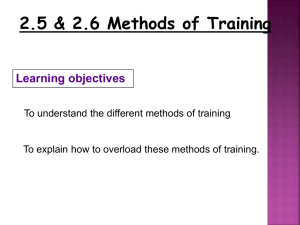Fatigue - sum extended rev
advertisement

Fatigue - the sum of its parts Running is simple, right? It’s just putting one foot in front of the other and racing is just doing that a little quicker. How complex can that be? Why would anyone get tired just doing that? The block diagram below provides a simplified view of the functional bits of the body that may contribute to that feeling of fatigue that any runner feels when they place a sustained demand on their body: the muscle fibres; the peripheral nervous system, and; the central nervous system. Brain Neuromuscular Junction Spinal cord Peripheral nerve Neurological fatigue Muscle Fibre Contractile process fatigue Fatigue is the body’s way of telling you to reduce demand so that homeostasis (a state of equilibrium between physiological processes) can be restored, but what is the physiological cause of fatigue? This may seem like a simple question, but finding an all-encompassing answer is a task that still occupies sports scientists. It seems that there are many inputs that that are integrated by the brain to produce what we know as fatigue. The relative importance of any of these inputs depends on the intensity and duration of the demand that is placed on the body. Fatigue itself is not a single state, but a continuum that has as its end point exhaustion when the body ceases to be able to do work. Complex biochemical processes in each muscle fibre act to allow those fibres to undergo cycles of contraction and relaxation. As energy is used in the contraction phase of muscle fibre action, it must be replaced so that the action can continue. The “magic molecule” that provides the energy that powers skeletal muscle (and other cells in the body) is adenosine triphosphate, or ATP for short. Complex biochemical processes inside muscle fibres (cells) can make ATP from the carbohydrates, fats and proteins we eat. The preferred “raw fuel” for the generation of energy by the muscle fibres to meet high demand exercise is a form of glucose (carbohydrate) stored in the muscles and liver as glycogen. There are three ways that ATP is produced in muscles: Anaerobic alactic energy process There is always a small amount of ATP in each muscle fibre and a quantity of a molecule called creatine phosphate (CP). As ATP is used to provide energy for the muscle contraction process, it loses a phosphate group to become adenosine diphosphate (ADP). ADP can be turned back into ATP by taking a phosphate group from CP. There is enough CP in the cells to provide ATP for around 8 seconds of maximum demand. The CP is regenerated in muscle cells when there is excess ATP. Anaerobic lactic energy process ATP can be produced using glucose without the need for oxygen. This process also produces lactic acid, which dissociates into lactate and hydrogen ions. As their concentrations increase, these biproducts inhibit the process that drives the contraction of the muscle fibres. This makes the anaerobic lactic energy process a self limiting process - the greater the rate at which ATP is developed using it, the less effective the process becomes. Essentially this is the body’s way of forcing you to slow down when the rate of demand for energy exceeds the capacity of the muscles to supply it. After around 20 seconds of maximum effort the energy output of the lactic system diminishes rapidly. As fewer muscle fibres act, the legs feel heavy. This is one cause of the sensation of fatigue. Lactate itself is circulated around the body and can be used to produce ATP in the presence of oxygen. Aerobic energy process This process is the one that we rely on to supply the bulk of the energy needed for most routine activities. In the presence of oxygen, glucose is used to produce ATP with the final bi-products being carbon dioxide and water. This process takes place in miniscule “energy factories” within the cell called mitochondria. The more mitochondria you have, the greater the capacity of the muscle cells to produce aerobic energy. The aerobic energy process can continue to supply energy for as long as there is glycogen in the muscles, oxygen is provided from the lungs through blood flow and waste products are removed. Carbon dioxide is one of these waste products and the lungs have an important role in removing it as, in the presence of water, it forms the weak acid carbonic acid, contributing to raised muscle cell acidity. When we begin a fast run, it is not an either/or regarding the above processes, but rather what proportion of the energy we are using that is provided by each system. The aerobic system is active in sedentary activities, but when demand rises sharply, the anaerobic system is required to provide greater power. The alactic ATP/CP system can provide energy at high power rates immediately, but not for long. The lactic system takes a little while to “crank up” to maximum output, but it too is soon exhausted if demand remains high. The aerobic system can provide a large amount of energy but requires breathing and heart rates to increase from rest levels to supply cells with sufficient oxygen to meet sustained high demand and even at its maximum output cannot approach the rate at which the anaerobic processes can provide energy. For a 60-100m sprint, the aerobic alactic system is the dominant one. An 800m race relies predominantly on the anaerobic lactic system. The aerobic system provides the majority of the energy for races of 3000m and upwards. It isn’t hard to see why fatigue is felt around the 250-300m mark in something like a 400m race when the energy output of the anaerobic systems has passed its peak and the aerobic system struggles to fill the gap. Why do you still get tired when you are running at a steady pace in a longer race, say over 5 or 10k when energy demand is within the capacity of the muscle fibres to supply it using the aerobic energy system? The muscle fibres are only one component in the system. There may be a degradation in function of the neuromuscular junction, the area where signals travel between peripheral nerves and muscle fibres. If these signals are impaired, fewer fibres are recruited and if enough fibres stop being enervated there is less force to move the limbs and we again interpret this as the legs feeling “heavy” and hence as fatigue. Similarly, electrical signals have to travel from the brain along the spinal cord and the peripheral nerves to the neuromuscular junction, a process that requires energy and which may degrade with extended, repetitive use. Impairment of signals to the muscle fibres again results in less power being generated and a feeling of fatigue. Within the brain, the process becomes more complex. We have an inbuilt tendency to move from a state of discomfort to one of greater comfort. Running at speed is not a state of maximum comfort and the brain will subconsciously seek to reduce the level of discomfort. The sensation of fatigue is one outcome of this, urging the non-trained endurance runner initially to slow down little by little and then stop, preferably close to a comfortable place to sit. This will happen even when the muscles and peripheral nerve system are quite capable of maintaining (or even increasing) the pace. For a trained athlete, the brain seeks to adopt a pace that is partly based on experience that will allow the race to be completed as fast as possible without serious damage to the muscles. In this case, the inputs that generate the feeling of fatigue result in a particular pace strategy. This pace is determined by the muscle fibre recruitment level of the brain, not the biochemical state of the muscle fibres. For evidence of this, watch how elite athletes are able to sprint the final stages of a distance race. Research has shown that, in endurance events, core body temperature is a key determinant of fatigue and therefore pace. As that temperature rises towards 40C, the brain’s recruitment of muscle fibres decreases. Muscle action produces heat and this internally produced heat is dissipated through the cooling effect of perspiration. As body temperature increases blood vessels near the surface of the skin dilate allowing a greater blood flow to the skin to promote cooling. This also reduces the amount of blood that can flow to the muscles. If the rate of production of heat exceeds the rate of loss of heat, body temperature will rise. If this happens, the brain acts to reduce the cause of the imbalance - muscle action - by recruiting fewer muscle fibres. Fewer muscle fibres recruited results in a reduction of power to the legs and hence a reduction in pace. So if you know what generates the feeling of fatigue that is all too often present in an endurance race, what can you do about improving your ability to tolerate it? Starting with the brain, there doesn’t appear to be a lot that you can do about the core temperature effect on pace in endurance events if your heat energy production exceeds heat loss. Clearly, a good strategy is to avoid high demand activities on hot humid days. If you do race in warm to hot conditions, adjust your pace and try to achieve the maximum heat loss possible through appropriate hydration, wearing loose fitting clothing. Lighter, smaller runners will generally be able to do better in hot conditions than larger heavier runners because they have a greater surface area to muscle mass ratio. With regard to the internal pacing strategy that the brain appears to adopt, if you are aware of your inbuilt, subconscious tendency to reduce discomfort, you can try to consciously over-ride the slow down signals. Incorporating aerobic race paces into your training program will assist you to develop neuromuscular recruitment patterns for various races. Running 1000m repetitions at 5k race pace with suitable recovery periods prepares the body to race at that pace. Accepting discomfort as a tradeoff to maintain your best race pace is something that you can train yourself to do. If you always train in the comfort zone, you will race the same way. You can train your muscles to buffer the acidity and other cell biochemistry changes that are a biproduct of the lactic process by doing repetition training that places a lactic demand on the body. Multiple 200 reps at 800m pace with short recoveries (or decreasing recoveries as a set progresses) is one way of doing this. You want the demand to be high enough to get the desired training effect, but not so high that you can only complete a few repetitions. This form of training also prepares you for the mental demands of middle distance racing. The rate at which breathing and heart rates can be brought up to a level that allows maximum aerobic output can be improved by doing reps where a demand is placed on that process - for example, continuous reps of 200 or 300m at 800-1500m pace alternating with 100m very slow jogs to allow breathing and heart rates to drop. Don’t forget that the lungs themselves rely on muscles to function and these muscles also need to be trained. Developing your aerobic energy capacity also requires that the muscle cells have the means to use the oxygen and fuel that is available to them. Sessions that place high demand predominantly on the aerobic system increase mitochondrial density in the muscle cells and hence the energy generation capacity of those cells. With regard to peripheral and central nerve fatigue, you can introduce sessions in your training program that place demands on these systems to work more efficiently. Doing 100m sprint reps, running as fast as you can while concentrating on running smoothly will place a demand on the nervous system to develop an efficient neuromuscular pattern that activates the muscles at a faster pace. This efficiency should carry over to slower race paces and hence improve running economy. All other race speeds are a fraction of your maximum speed so it is a good idea to keep that speed as high as possible. Include sessions in your training program that are done at specific race paces so that you become better at judging pace and can “lock into” a race pace you have trained at. There is no point in running 1000m reps at 4min/km pace if your aim is to run a 5km race in 18 minutes. When you are running at your best aerobic pace the brain will recruit the best trained groups of muscle fibres first and then gradually replace these with other fibres as the race progresses. Unless these other fibres are also well trained (ie demands have been placed on all fibres in your training), your pace will decrease as the race progresses. This is a good reason to do some training sessions that require a 100% effort, placing demand on all muscle fibres. If your training consists only of long slow runs, then you will get good at doing long slow runs. Running further will not make you run faster as this does not recruit and train the muscle fibres you need for speed. There are many variations of training sessions that provide ways of physically and mentally improving your ability to tolerate what we experience as fatigue. Think about the major factor that causes the fatigue that you feel in your event and devise training sessions that place a graded demand on that factor. No demand means no change. This form of training will involve discomfort, but it should not involve pain. Pain is an indicator of injury and you should lower demand if you experience pain. Stop altogether if that pain increases and seek a diagnosis of the cause. Training is means to an end, but cannot provide all of the experiences you need to performa t your best. You learn to race well by racing. By itself, training does not produce the mental demands that racing does. Many races come down to tactics and you need to not just go into a race with a “game plan”, but also to be able to adjust that plan when competitors don’t play your game. National and international races have organisational procedures that can create a high level of mental stress before a competitor even gets to the start line and this can add to a feeling of fatigue. There are some medical potential sources of fatigue that masters athletes may experience including, but not limited to, the following: • If you have joint problems, these may produce localised inflammation and/or pain as a race progresses that can add to the inputs to fatigue outlined above. • Exercise induced asthma or other respiratory problems may occur, limiting oxygen intake. • Low levels of essential minerals and vitamins may also cause problems. The oxygen carrying capacity of the blood is dependent on a molecule called haemoglobin for which iron is essential. Low levels of stored iron or of iron circulating in the blood can result in anaemia and hence be a factor in fatigue. • Vitamin B12 and folate are needed for healthy cell development, including that of blood cells. B12 deficiency leads to a condition called pernicious anaemia which contributes to a feeling of fatigue. Discuss your athletic activities with your doctor and have a blood test every year or so that includes iron studies, B12 and folate levels. It is a good idea to have regular medical checkups anyway to monitor your physical condition and treat any emerging issues before they become serious problems.



